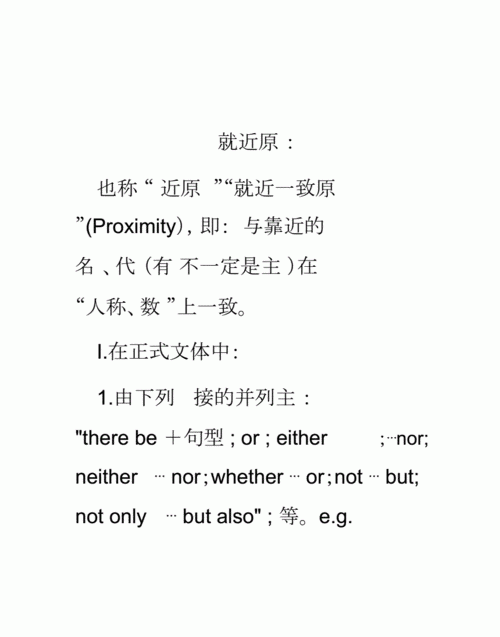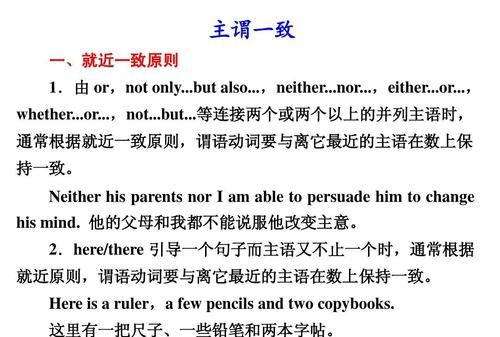本文目录
neither …nor遵循就近原则还是就远原则
neither nor就近原则:以靠近谓语动词的、作主语的名词作为人称和数的参考标准,即谓语动词单复数要参考nor后的主语人称。
例如:
Neither he nor they are wholly right.
他和他们,谁都不是完全对的。

就近原则
就近原则也称“邻近原则”“就近一致原则”,即:谓语与靠近的名词、代词(有时不一定是主语)在“人称、数”上一致。与其相对的还有“就远原则”。
一、由下列词语连接的并列主语:there be+句型;or;either …or;nor;neither…nor;whether…or;not…but;not only…but also等。
二、在倒装句中:谓语可与后面第一个主语一致。
either or 和neither nor是遵循就近原则
有就近原则。
Neither the students nor the teacher knows anything about it.
Neither he nor they are wholly right.
但是neither单用就没有就近原则,后面是加单数的
满意请采纳,不懂可追问

Neither nor是不是就近原则
neither...nor...表示"既不……也不……".其含义是否定的,可连接任意两个并列的成份.
当neither...nor...连接两个主语时,应遵循"就近原则".
就近原则 【就近原则】
也称“邻近原则”“就近一致原则”(Proximity),即:谓语与靠近的名词、代词(有时不一定是主语)在“人称、数”上一致.
I.在正式文体中:
1.由下列词语连接的并列主语:"there be+句型; or ; either …or;nor; neither…nor;whether…or;not…but; not only…but also" ; 等.e.g.
①What he does or what he says does not concern me .他的行为或言谈都与我无关.
②Neither you nor I am wrong .你和我都没错.
③Not you but your father is to blame .不是你,而是你父亲该受责备.
④Not only you but(also) he is wrong .不仅你错了,他也错了.
2.在倒装句中:谓语可与后面第一个主语一致.e.g.
①In the distance was heard the clapping of hands and the shouts of the people .在远处,能听见鼓掌声和人们的呼喊声.
②There is (are) a pen and some books on the desk .桌上有一支钢笔和几本书.
II.非正式文体中:
有时依“就近一致原则”,但也可依“意义一致原则”或严格地依“语法一致原则”.e.g.
Neither she nor I were there (意义一致) 我和他当时都不在那儿.(非正式)
Neither she nor I was there .(就近一致)(译文同上句)(正式)
但是,如果依“就近一致原则”而与其他两项原则相矛盾时,则常常认为是不太合符规范的.e.g.
No one except his own supporters agree with him .仅他自己的支持者同意他的意见.(依“就近”和“意义”一致的原则;但语法上,“No one ”才是主语,谓语要改成“agrees”.“写作中”一般要依“语法一致”原则.
【就远原则】
谓语动词与前面主语一致
代表词汇:as well as;(together/along)with;rather than;except;besides;but;including;in addition to;apart from
E.G:He rather than I is right.
Nobody but two students is in the classroom.

Neither nor是不是就近原则
neither nor 需要就近原则。就近原则,也称“邻近原则”“就近一致原则”(Proximity),即谓语与靠近的名词、代词(有时不一定是主语)在人称与数上保持一致的原则。
常见的需要就近原则的:
1、由here, there, where 等引导的倒装句中, (有时主语不止一个时)谓语动词与靠近它的主语在数上一致。
如:Here comes the bus 公共汽车来了.
Here is a pen and some pieces of paper for you. 给你一支钢笔和几张纸。
Where is your wife and children to stay while you are away?你不在这儿的时候, 你爱人和孩子在哪儿呆呢?
2、用连词or, either.... or, neither….nor, not only….but also 等连接的并列主语, 谓语动词与靠近它的主语在数上一致。
如:Neither the students nor the teacher knows anything about it 学生和老师都不知道这事.
He or you have taken my pen. 他或你拿了我的钢笔。

扩展资料
就近原则与语法一致原则、意义一致原则并成为主谓一致中三大原则,当就近原则与其它两种原则发生冲突时,应优先考虑其它两种原则。
就远原则就是谓语动词的变化即:谓语动词与前面主语一致。
如下的词用就远原则:
as well as、(together/along)with、rather than、except、besides、but、including、in addition to、apart from。
以上就是关于neither要就近原则 ,neither …nor遵循就近原则还是就远原则的全部内容,以及neither要就近原则吗 的相关内容,希望能够帮到您。
